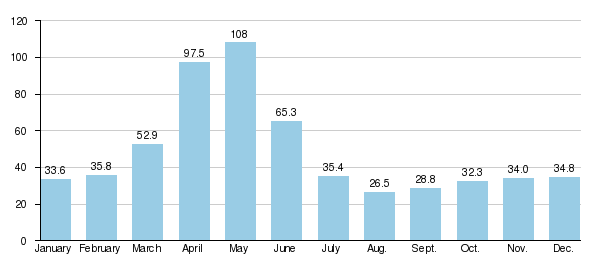Murghab River

The Murghāb River (Persian/Pashto: مرغاب), also called Margos, Margu and Margiana River (Old Greek: Μαργιανή), and also transliterated as Murgab (from Russian Мургаб) and Murgap (from Turkmen), is an 850-kilometre (530 mi) long river in Central Asia. It rises in central-western Afghanistan and runs north-west towards the Murghab District, which takes its name from the river, and then the Kara Kum desert in Turkmenistan, where it peters out.
Geography
The Murghab originates in central-western Afghanistan, on a plateau situated among the chain of mountains of Paropamisus, Gharjistan and Band-i Turkestan. In its higher course, oriented from east to west, and to the locality of Mukhamedkhan—i.e. over a length of 300 kilometres (190 mi)—the valley of Murghab is narrow, measuring less than one kilometer in width, with steep slopes. There are narrow gorges in some places. Between Darband-i Kilrekht and Mukhammedkhan, the Murghab crosses the western part of Band-i Turkestan. It then runs toward the northwest in a deep canyon. In Mukhammedkhan, it crosses the gorges of Jaokar. After this, the valley widens somewhat gradually, reaching a width of 2 kilometres (1.2 mi) in Turkmenistan. Beyond Mukhamedkhan, a small portion of the water of the Murghab is used for irrigation; approximately 10,000 hectares (25,000 acres) are irrigated from the Murghab in Afghanistan. The Murghab receives the waters of the Kaysar river on the right, then forms the border between Turkmenistan and Afghanistan over a 16-kilometre (10 mi) length. In the territory of Turkmenistan, close to Takhta-Bazaar, the Murghab receives the Kachan river from the left bank, and 25 kilometres (16 mi) further, there is the confluence of the Kushk. Reaching the oasis of Merv, the Murghab mingles its waters with those of the Karakum Canal, a diversion of water from the Amu-Darya.
Catchment area
The catchment area of the Murghab is estimated at 46,880 square kilometres (18,100 sq mi).[1]
Hydrometry - the flows at Takhta-Bazaar
The flow of Murghab was observed during 50 years (1936–85) at Takhta-Bazaar, a location in Turkmenistan about 30 kilometres (19 mi) after the Murghab leaves the Afghan territory, and a score of kilometers upstream of the confluence with the Kushk.[2] At Takhta-Bazaar, average annual flow observed over this period was 48.7 cubic metres per second (1,720 cu ft/s) for an observed surface area of 34,700 square kilometres (13,400 sq mi), which is 74 percent of the totality of the catchment area of the river. The geographically-averaged hydrometric flow passing through this part of the basin, by far greatest from the point of view of the flow, thus reached the figure of 44.3 millimeters per annum, which is very appreciable in this particularly desiccated area.
Monthly mean flows of Murghab (in cubic meters per second) measured at the hydrometric station of Takhta-Bazaar
Data calculated over 50 years

References
External links
| Wikisource has the text of the 1911 Encyclopædia Britannica article Murghab. |
- "Delft Hydraulics - Integrated Water Resources Management for the Sistan Closed Inland Delta - ANNEX B : Forecasting the Flow from Afghanistan - Page 18 : cartes hydrographiques d'Afghanistan" (PDF). (1.50 MB) (in English)
- Map of the province of Ghor, with trace of the flow of water
- Map of vegetation cover in the province of Badghis, with trace of the flow of water
- "Morghab River", in Britannica
Coordinates: 36°26′47″N 62°38′06″E / 36.44639°N 62.63500°E